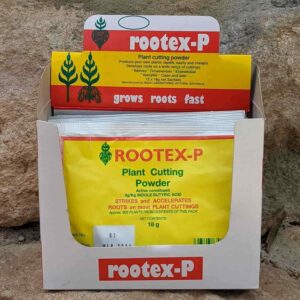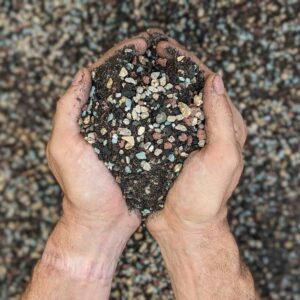Basic: Zeolite is a type of rock/gravel which is most commonly known for its use as water filters, purification media and cat litter, but is also a popular soil additive.
Advanced: Zeolites are microporous, naturally occurring minerals composed of hydrated, natural calcium-aluminium-silicates and they are used in a variety of industries for their unique natural filter properties.
The applications for zeolites go much further than you might expect – and they’re especially great as an addition to cactus growing media (soil mix) due to their ability to constantly and slowly release important macro elements for plants such as potassium (K), without adding excessive nitrogen.
Let’s explore what zeolites are, why you should add them to your cactus soil mix and some of the benefits they provide.
What is zeolite?
Zeolites are minerals composed of hydrated, natural calcium-aluminium-silicates. There are over 40 types of Zeolite and they can be naturally occurring volcanic rocks or synthetic. Chemically, Zeolite contains sodium (Na), potassium (K), Calcium (Ca), barium, magnesium, and strontium.
Horticultural Zeolite is a naturally occurring volcanic rock with a high cation exchange capacity (CEC) and water absorption thanks to the high content of “tectosilicates” minerals such as chabasite and phillipsite. In a horticultural application, it acts as an important ion-exchange agent and a natural filter, having also the capacity to release over time, constantly, potassium (K), which is a very important macro element for plants.
Zeolite has a very unique chemical structure characterised by channels and pores that allows water to pass through, similar to pumice or perlite. However, unlike pumice or perlite, its high CEC also allows zeolites to absorb and freely exchange positively charged cations, such as Ammonium Nitrogen and Potassium which are valuable nutrients to our plants.
Benefits of adding zeolite to cactus soil.
The addition of zeolite into potting mixes regulates the uptake of essential nutrients such as ammonium nitrogen (NH4+), potassium (K+) and magnesium (Mg+), calcium (Ca+) and trace elements. It does this by absorbing excess nutrients from the organic material present in the mix and storing it within the porous structure of the zeolite. When a particular nutrient becomes deficient in the solution around the root zone, it is released from the zeolite and made available to the plant at their request – think of it like a plant nutrient battery. This greatly reduces the leaching of excess nutrients from the mix and ensures more efficient use of applied fertiliser. In general, plant health and colour are improved with the use of zeolite and the life of applied nutrients in the mix is extended.
This is particularly valuable for cacti as they do not generally tolerate the water-retentive qualities of most commonly used nutrient-rich soil mediums such as compost or manure. Cacti require fast-draining growing media that can still provide the maximum amount of nutrients, which is a difficult balance to achieve. Zeolite, with the addition of fertilisers, can achieve this as Zeolite retains the same draining effect as pumice: preventing water stagnation and rot, whilst assisting soil aeration when dry.
In addition, due to its natural filter abilities, Zeolite can block impurities and odours from entering your soil, reducing instances of disease which can impact the health of your cacti.
How to add zeolite to your cactus soil mix.
As mentioned, there are over 40 different types of Zeolites and it comes in many different granulations for different applications. The stuff you want for your cactus mix is Horticultural Zeolite and looks like small red/brown (sometimes green) pea gravel, not the powder form. For small and young cacti a granulation size of 2-5mm works well, for established and large cacti adding some larger 5-20mm has produced great results for us.
When adding zeolite to your cactus soil mix, it’s important to understand and account for the fact that zeolite itself does not contain the majority of the nutrients required for the plant – it simply improves access to nutrients found in the rest of the mix. Through our own testing, we have found the best way to add zeolite to your cactus soil mix is to use a ratio of about 10% zeolite to 90% other ingredients, well blended. This ratio ensures that enough zeolite is present to provide valuable benefits to our mixture, but not enough to take away from other essential ingredients in the mix.
Where to find Zeolite?
Zeolite can be found at speciality horticultural, gardening and rural trading stores or online by searching for “Horticultural Zeolite”. Avoid zeolite from pool stores, it is chemically similar but the granulation size will most likely be too fine to be useful for your needs. If you’re not sure which one to get, be sure that it has the word “zeolite” in the product name and that it is gravel, not a powder. So long as it says Zeolite and isn’t a powder you have probably found the right stuff.
In Summary (the short version)
Zeolites are a naturally occurring mineral used in a variety of industries due to their unique ability to filter impurities and odours from water, gases and ions. Zeolites can also be used as an excellent addition to cactus soil mixes due to their ability to slowly release potassium (K), calcium (Ca) and other essential plant nutrients whilst simultaneously improving with drainage. Zeolites can easily be found at most local gardening stores or online. When adding zeolite to your cactus soil mix, it’s important not to overdo it, a ratio of 10% Zeolite in the mix will suffice.



